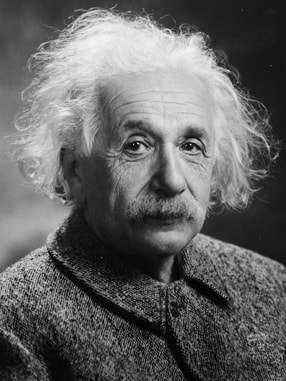 Albert Einstein Albert Einstein When it comes to scientists, one of the most recognized names in our world is that of Albert Einstein. Einstein, who won the Nobel Prize in Physics in 1921, is the creator of the theory of relativity which led to the prediction of amazing things such as deflection of light by gravity, gravitational lensing, black holes, gravitational waves, and the expanding universe, all of which have all been proven by many observations and experiments. Einstein ushered in a revolution in physics. He clearly was a genius, but in some aspects the way his mind worked was no different from that of any average human being. Deflection of Light Both Newton’s theory of gravitation and Einstein’s theory of relativity predicted that light would be deflected by a strong gravitational field, but Einstein’s theory predicted that light would be deflected by an amount roughly double of that predicted by Newton’s theory. In 1919 during a solar eclipse, it was observed that indeed light from stars close to the sun was deflected by an amount compatible with Einstein’s theory. This result, which made Einstein a worldwide sensation, has been verified with increasing accuracy many times since then. But what is less well known is that Einstein had originally made a calculation error which led him to find a deflection value no different from that predicted by Newton’s theory. This meant that the observation of the deflection of the light of stars by the sun would have disagreed with both theories. Thankfully, by the time the observation was made, Einstein had corrected his mistake, and the actual magnitude of the deflection agreed with his theory. Gravitational Lensing Einstein had figured out that, according to his theory of relativity, the strong magnetic field of a star could act as a lens and amplify the light of other distant stars behind it. But he realized the effect would be very small and fleeting, so did not deem it worthwhile publishing anything about it. However, in 1936 an amateur scientist named Rudi W. Mandl also figured out that this was one of the consequences of Einstein’s theory. He contacted Einstein who agreed the effect was indeed predicted by his theory and, after some pestering, consented to write an article about it. Einstein wrote the article acknowledging Mandl’s contribution, but stated in it that there is no chance of observing this phenomenon. At the time Einstein wrote this, he was thinking in terms of stars because the realization that there were distinct galaxies beyond our own was relatively new, and astronomers had not yet understood the real vastness of the universe. But astronomers eventually figured out that entire galaxies could act as gravitational lenses, and the first example of such a lens was discovered in 1979. Black Holes Another consequence of the theory of general relativity was the possibility of the existence of black holes, but Einstein was also dismissive of these entities, and he published an article in 1939 using his own theory to argue that black holes did not exist. In the decades after Einstein’s death in 1955, the evidence for the existence of black holes accrued until 2019 when a black hole was photographed for the first time. Gravitational Waves Einstein’s theory of relativity included the possibility of the existence of gravitational waves, but he confided to some colleagues that he was skeptical about their existence or the possibility that they would ever be detected. He followed this by another article where he specifically examined the math behind such waves, but in this article, as was pointed out to him by other scientists, he made a calculation error. Two years later, he published another article where he corrected his previous error and finally laid down the correct mathematical framework for describing gravitational waves. However, Einstein remained skeptical about the reality of such waves. Two decades later, in 1936, Einstein revisited the issue of gravitational waves in another article where he argued that the math really did not favor of the existence of such waves after all. He sent this article for publication in a science magazine, but the magazine sent the article to a reviewer who found a mistake in Einstein’s calculations. When Einstein redid the calculations, he found that the math did support the existence of gravitational waves after all! Still, the whole notion of the existence of gravitational waves was too outrageous for Einstein to accept. Untill the day of his death, he remained skeptical that these waves were anything but a mathematical construct, and even if they were real, he thought that they would be so faint that it would be impossible to detect them. The first gravitational waves were detected in 2015. Expansion of the Universe In 1917, Einstein wrote an article where he used his theory of general relativity to examine the universe. To his surprise, he found that the math indicated that the universe would expand forever. However, astronomical knowledge at the time indicated that the universe was supposed to be unchanging, so Einstein came up with a mathematical solution. He included a “cosmological constant” in the calculations, which prevented the universe from expanding forever. Other scientists challenged Einstein on this notion to the point that he conceded his original math without the constant was right, but he still doubted the reality of his conclusions. It was only after Edwin Hubble demonstrated in 1929 that the universe is indeed expanding that the prediction of Einstein’s theory were found to be right. The above reveals how one of the greatest minds that humanity has ever seen worked. Einstein made mistakes. He was unsure about the implications of his theory. He changed his mind several times. He doubted or dismissed the existence of some of the very things that he is credited with predicting, and he sometimes even lacked the vision to imagine future realities. This is how real science works and what real scientists are like. Science is messy. Scientists screw up. They vacillate, they change their minds, and sometimes they are unable to grasp the real consequences of the very things they propose. This IS normal, and is something that happens to everyone. But in the current poisoned climate where scientists on the “wrong” side of the culture wars are attacked for making mistakes, flip-flopping, or saying the wrong thing during an interview and so forth, one wonders if, for example, the discoveries that Einstein made would have been possible if he had been subjected to the scrutiny and slander that some scientists are subjected to nowadays. The photograph of Albert Einstein by Orren Jack Turner obtained from the Library of Congress is in the public domain because it was published in the United States between 1923 and 1963 and the copyright was not renewed.
0 Comments
Science has been under attack recently by vociferous and often politically motivated individuals. But science is the best method we have to discover the laws that govern the behavior of matter and energy in our universe, which allows us to generate applications that work. This is not an opinion. This is a rock-solid fact. And if you want evidence for this claim, just look around you. Computers, cell phones, televisions, microwaves ovens, refrigerators, air conditioning, buildings, vehicles, airplanes, dams, satellites, space stations, telescopes, etc. Keep looking. Antibiotics, antivirals, antivenoms, hormones, erectile disfunction drugs, surgical techniques and science-based therapies, DNA sequencing, vaccines, etc. If science were not a successful method to uncover reality, none of these things would work. When faced with this evidence, the people who attack science would probably clarify that what they are attacking is the scientists, not the principles of science. These people claim that scientists have been corrupted by powerful interests and/or by the need to obtain funds, which leads them to fake or selectively interpret the data. This claim, however, is quite startling. If what scientists are coming up with does not reflect reality because they are faking the science, then it should not work. But how are we to explain the list of scientific applications that work that I presented in the previous paragraph? One would have to argue that these discoveries were made in a pristine past when science was not corrupted, and that the corruption of science is a recent event. Now please, if you really believe this, send me a message, because I’ve got a bridge I want to sell to you. Not only is this not true, because there have been recent scientific applications that work such as, for example, the COVID-19 vaccines, but dishonesty and corruption have always plagued humanity. Institutions ranging from government, political parties, unions, and religious organizations, to neighborhood associations, clubs, and family businesses everywhere have experienced dishonesty and corruption. And because scientists are human beings, they are prone to dishonesty and corruption too, but those discoveries I outlined in the first paragraph were made despite the influence of dishonest and corrupt individuals. Although the methodology of science has several safeguards to insure that the science is right and free from dishonesty, the ultimate proof that science works is in the applications. If a purported practical application of science doesn’t work, then the unavoidable conclusion is that the science behind it was deficient. Those that criticize science or scientists in the way I described above are missing the most important point. Our primary concern should not be that the science doesn’t work because corrupt individuals are somehow “faking it”. This way of thinking is divorced from reality and fails to recognize the main problem with science. The main problem with science is that it works, and that is what should scare us. Let me explain. Most of us are honest individuals who know that science will deliver for us and we use the applications generated by science in a lawful way. However, there are dishonest individuals who also know that science will deliver for them too, and these individuals are willing to pervert the use of the applications generated by science. This is especially true when there are strong demands for accomplishments, incentives for success, and millions of dollars in profits on the line. For example, pharmaceutical companies have paid billions of dollars in fines for engaging in off-label promotion of their products, paying kickbacks, and Medicare fraud. The most glaring example of misconduct in the pharma industry is the horrifying opioid epidemic that began with the lax FDA approval of the pain drug oxycontin from Purdue Pharma, followed by its inappropriate marketing, which led to millions becoming addicted and hundreds of thousands dying. Thus the true and frightening power of science derives from the fact that you can be certain that it works, and that therefore, someone somewhere will misuse what science produces. To counter this we need to exercise and demand vigilance. We need to pressure our elected representatives to police those charged with the application of science. We need to monitor our elected representatives and make sure they are not corrupted by bribes or favors. We need strong and independent watchdog groups and media outlets to keep an eye out for misconduct and conflicts of interest. We have to demand changes to regulations and procedures to ensure that the process of approval of scientific applications doesn’t become corrupted by political or corporate interests. But we cannot do this effectively if part of our energy is devoted to countering those that incessantly claim the science is “fake” or “junk” and that it does not work. It's not fake science but the misuse of scientific applications that we should be concerned about. The image of the Hand Holding a Sign from pixabay by geralt is in the public domain and has been modified.  Calvin and Hobbes Calvin and Hobbes In Facebook I belong to a group that pays tribute to one of my all-time favorite comic strips, Calvin and Hobbes, written by Will Watterson. Watterson's strip about a hyperkinetic albeit imaginative kid named Calvin and his alter ego stuffed tiger, Hobbes, ran from 1985 to 1996 in the United States. Calvin, is the quintessential brat who often strains the nerves of his mostly tolerant parents, while Hobbes plays the straight man to Calvin’s antics. The comic strip often parodies modern life at the personal, family, and societal levels. The most salient feature of the comic strip is Hobbes. When someone besides Calvin is around, Hobbes is shown as a stuffed toy tiger, but when Hobbes is alone with Calvin, he is portrayed as a walking talking tiger. This has been interpreted in several ways by fans of the strip, with some people claiming that the walking talking Hobbes is a figment of Calvin’s imagination while others claim that the tiger actually comes alive when he’s alone with Calvin. One of the members of the Facebook group posted what Watterson once wrote about the ambiguity of Hobbes’ nature. The so-called "gimmick" of my strip — the two versions of Hobbes — is sometimes misunderstood. I don't think of Hobbes as a doll that miraculously comes to life when Calvin's around. Neither do I think of Hobbes as the product of Calvin's imagination. Calvin sees Hobbes one way, and everyone else sees Hobbes another way. I show two versions of reality, and each makes complete sense to the participant who sees it. I think that's how life works. None of us sees the world exactly the same way, and I just draw that literally in the strip. Hobbes is more about the subjective nature of reality than about dolls coming to life. I took exception to this, and I posted on the group’s page the following: “This is not true. There is only one reality. We may perceive it in different ways, but those perceptions still have to have a high degree of correlation to reality for life to be possible. If I see the edge of a cliff and you don't, I will survive, and you will die. Seeing a walking talking tiger instead of a stuffed tiger is not just ‘another way’ to perceive reality, it is a fantasy. There are perceptions of reality which may make sense to some people, but they are false.” A few people replied to my comment making several claims. Among these where that “everyone has their sense of reality’, that “there is no consensus regarding the interpretation of reality”, and that research into the quantum realm validates this notion; that “only those dogmatically adhering to their own perspective dare speak with any certainty when it comes to asserting that their interpretation of reality holds all due authority and finality in its validity”, and “what makes you an expert on reality? How do you know that for one a thing is not real that is for another?”. I wanted to put together my replies to some of these comments in this post, because the implications go beyond a mere comic strip. I understand that the perception of reality by different people can be different: for example, color blind people vs people with normal color vision. In fact, our perception of reality doesn’t even have to be “veridical”. However, as I stated in my comment, there has to be a big enough correlation between reality and our perception of it for life to be possible. All around us the world is full of patterns, regularities, and things happening one way and not another, that allow us to figure out how to go about living. Reality is not anarchical, and there are millions of consensuses regarding the nature of reality all around us. For example, the sidewalk under our feet WILL NOT turn into quicksand and swallow us, a tree WILL NOT uproot itself and chase us, a cloud WILL NOT turn into lead and fall on us, etc. We don't have to live in fear of these occurrences, because we have internalized how the world works. This ability is part of our evolutionary programing and has survival value. Scientists go beyond this intuitive understanding of reality that we have all developed by performing tests to gain insight into more complex aspects of reality and they discard those views of reality that are incompatible with the evidence. With the exception of the quantum realm, so far all the evidence we have indicates that, at least at our level, we live in a deterministic world. Things are one way and not another. Some things are possible, and others aren’t. I agree that some individuals see a reality that is very different from the one the rest of us see, but many of those people are unable to function in the real world and can even put their lives and those of others in danger. That is why they are treated with medication or locked up in psychiatric wards. Their view of reality IS NOT an “alternative view”, it is a FALSE view. I agree children often see reality in a way that is different from adults, but this is why they are treated like children and are under the care and supervision of adults. And it is our job as adults to assist in weaning them of their childhood fantasies, so they can take their place in the adult world. Of course, when I post things like these, I come across as an arrogant, insufferable, “know better than thou” jerk divorced from the magic of childhood who is disrespectful of other people’s points of view. Let me just state two things. 1) I am a fan of fiction and fantasy. From Lord of the Rings and Harry Potter to comic strips such as Calvin and Hobbes, Bloom County, or The Far Side; and from the numerous incarnations of the Star Trek franchise (I’m a Trekkie) to many works of horror such as Frankenstein, Dracula, Aliens, Night of the Living dead, Nightmare on Elm Street, Psycho, The Texas chainsaw Massacre, or the Rocky Horror Picture show. I enjoy fiction and fantasy and find inspiration in them, so much so that I also write short stories. Fiction and fantasy have important roles in adulthood, but they ARE NOT reality, and as adults we must recognize this. 2) Reality is not a democracy, and alternative views of reality, especially those unsupported by evidence are not always valid or worthy of respect. Are the QAnon folks right in their claims of the existence of a worldwide cabal of satanic, cannibalistic, pedophiles? Was the 2020 presidential election a fraud? Was 911 an inside job? Is COVID-19 no worse than the flu? Will the COVID-19 vaccine modify your DNA and implant a microchip that will allow the government to track you? Was the moon landing a hoax and is the Earth flat? Was the Earth and all life on it created 10,000 years ago? Is the government spraying you with chemicals? These are not “alternative” views of reality, these are FALSE views of reality and should be treated as such. So, to wrap it up, yes, by all means enjoy and be inspired by Calvin and Hobbes (or other works of fiction and fantasy), but all the while understanding that Hobbes IS NOT a walking talking tiger but just a figment of Calvin’s imagination. Calvin and Hobbes image by Bill Watterson is a Wallpaper from flickr by Brad Arnold and is used here under an Attribution-NoDerivs 2.0 Generic (CC BY-ND 2.0) license. My father used to say that there is a fine line separating the sublime from the ridiculous, and he was right about this. I have read about people who achieve the sublime. They discover important things that change the world, or perform physical feats, or give speeches, or write books, poems, or songs that serve as an inspiration for millions of people. And then years later I learn these very same people became mired in the ridiculous when they were caught engaging in criminal behavior, or saying or doing embarrassing things, or defending ideas that were wrong, immoral, objectionable, or silly. Even Nobel Prize winning scientists are not immune from this. It seems that for a few scientists, the very thought processes and character traits that led them up the path to the sublime, also thereafter diverted them down the slope to the ridiculous. Today we will take a look at a few of these scientists. 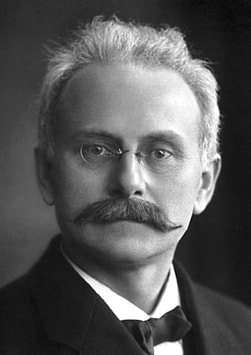 Johannes Stark Johannes Stark Johannes Stark The Sublime – Stark was a German physicist who discovered the splitting of spectral lines of atoms and molecules in an electric field (today known as the Stark effect) which provided an important confirmation of the model of quantum physics of the atom. For this and other discoveries he received the Nobel Prize in physics in 1919. The Ridiculous – Stark grew very vocal in criticizing mainstream physics and became involved in many disputes and power struggles, growing erratic and disruptive. The German scientific community shunned him, but when Hitler began his rise to power, Stark supported him and attacked the work of Jewish scientists in Germany, especially Albert Einstein. Stark joined the Nazi party, and assumed a leading role in a movement to rid German science of Jewish scientists and their ideas. However, he was eventually sidelined due to his incompetence as an administrator as well as his quarrelsome nature. Stark retired, and after the war he spent one year in jail for his associations with the Nazis. 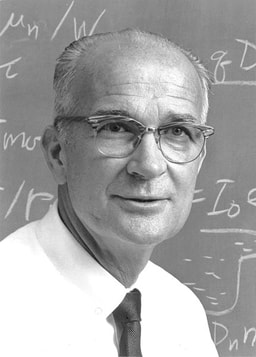 William Shockley William Shockley William Shockley The Sublime – Shockley was an American physicist who performed vital work for the United States navy during World War II that allowed the US to increase its success in tracking and attacking German submarines as well as evading German bombers, which saved many lives. He led the team at Bell Labs which invented the transistor, and then he improved on the device to produce a version on which most transistors are based today. For this discovery, Shockley and his team were awarded the Nobel Prize in physics in 1956. After leaving Bell Labs, he founded a semiconductor company and attracted the talented people who would later go on to found companies that would usher a technological revolution in electronics in what is now known as Silicon Valley in California. The Ridiculous – Shockley had a difficult temperament that caused him problems both in his family and professional life. He was rude and arrogant, and his managerial style was that of a dictator. Many people that worked with him for a while ended up leaving or refusing to work with him ever again. After he won the Nobel Prize, he started espousing racist views regarding the excessive reproduction and intellectual inferiority of certain groups of people or races and lashing out against his critics. He died only in the company of his second wife and estranged from his children and former friends and colleagues. 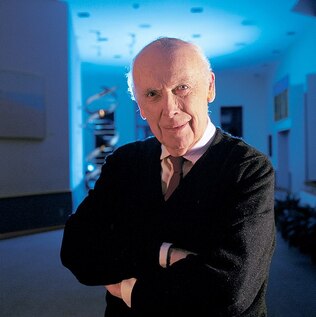 James Watson James Watson James Watson The Sublime – Watson is an American molecular biologist and the co-discoverer with Francis Crick of the structure of the molecule of life, DNA. This single discovery brought about a dramatic transformation in the biological sciences that is still ongoing. Watson along with Crick received the Nobel Prize in Physiology or Medicine in 1962. But what made Watson a household name was his memoir about the discovery of the structure of DNA entitled The Double Helix which he wrote in a brash not-suffer-fools-gladly style which excited the imagination of a generation of scientists. The Ridiculous – Watson has expressed controversial views including that blacks are less intelligent than whites, that some anti-Semitism is justified, and that women scientists are less effective and not as good at math as men and will not be taken seriously in science if they have children. But he also thinks that having some female scientists around makes things “more fun for the men”. He has also claimed that fat people are less ambitious than thin people, that libido is linked to skin color, and that if it were possible, parents should be allowed to choose the traits of their unborn children such as not choosing to have a homosexual child. 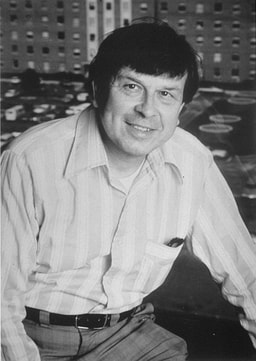 Carleton Gajdusek Carleton Gajdusek Carleton Gajdusek The Sublime – Gajdusek was an American physician who studied a rare and puzzling disease called Kuru prevalent among members of the Fore tribe in New Guinea. He found that it was spread by ritualistic brain cannibalism, and he succeeded in transmitting the disease to chimpanzees by injecting human brain extracts into their brains. Gajdusek observed that Kuru had similarities to another human disease called Creutzfeldt–Jakob disease and to a disease of sheep called scrapie, and he proposed that the pathogen was a previously unknown infectious agent which he termed “unconventional virus”. Gajdusek received the Nobel Prize in medicine and physiology in 1976 for his work on new mechanisms of dissemination of infectious disease. The pathogens in these diseases were later found to be misfolded proteins called prions. The Ridiculous – Over the years Gajdusek adopted many boys from the Fore tribe, brought them over to the U.S. to live with him, and put them through high school and college. One of these individuals accused Gajdusek of molesting him when he was a child. Gajdusek pled guilty to the charge and spent one year in jail after which he was released, relocated to Europe, and never came back to the U.S. 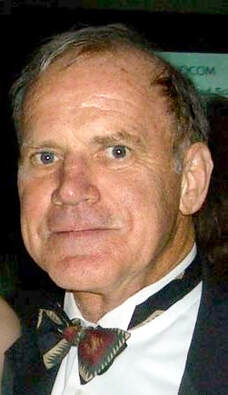 Kary Mullis Kary Mullis Kary Mullis The Sublime – Mullis was an American biochemist who invented a method to amplify DNA, the polymerase chain reaction (PCR), which brought about a revolution in areas ranging from medicine to forensics. PCR is used in the diagnostic test for COVID-19. Mullis received the Nobel Prize in Chemistry in 1993. The Ridiculous – Mullis became infamous for his belligerent attitude and outrageous eccentric behavior. For example, he was once invited to give a lecture about PCR, and instead he criticized the science behind the treatment of AIDS, and the only slides he presented were photographs of naked women. His professed belief in astrology, ghosts, and aliens, as well as his denial of the ozone hole, global warming, or that the HIV virus causes AIDs also made him toxic in the eyes of most scientists.  Luc Motagnier Luc Motagnier Luc Montagnier The Sublime – Montagnier is a French virologist who with Françoise Barré-Sinoussi won the 2008 Nobel Prize in physiology or medicine for their discovery of the AIDS virus (HIV). This discovery along with the work of Robert Gallo in the United States made it possible to produce antivirals and save the lives of millions of people. The Ridiculous – After receiving his Nobel Prize, Montagnier started publishing research claiming that DNA can emit electromagnetic waves and create a memory of itself in the water used to dissolve it. He also claimed that this memory emits such waves allowing the DNA to teleport between solutions. Montagnier’s claims were interpreted as favoring the pseudoscience of homeopathy. He has also given talks at anti-vaccination conferences, claimed that AIDS can be cleared through nutrition and supplements, and that the COVID-19 virus is man-made. Montagnier has become a pariah to the scientific community. As the above list (which is by no means exhaustive) shows, scientists are human beings, and even Nobel Prize winning scientists can make errors of judgement and display all the character flaws and contradictions that affect average individuals, and this can take some of them all the way from the sublime to the ridiculous. Photograph of Johannes Stark by A. B. Lagrelius & Westphal is in the public domain. Photograph of William Shockley by Chuck Painter is used here under an Attribution 3.0 Unported (CC BY 3.0) license. The photographs of James Watson and Carleton Gajdusek are works of the NIH and therefore are in the public domain. The photograph of Kary Mullis by Dona Mapston is used here under an Attribution-ShareAlike 3.0 Unported (CC BY-SA 3.0) license. Photograph of Luc Montagnier by Prolineserver is in the public domain. The general public believes that successful scientists are those who discover something important or propose a new theory that explains things that no one could explain before. However, this belief leaves out a critical detail. How is it decided whether the discovery is valid or the theory is right? After all, maybe the scientists made a mistake in the observations and/or experiments that the discovery is based upon, or maybe the scientists missed some crucial details when formulating the theory. Who decides if this is the case? The answer is: their peers. The work of scientists is evaluated by their peers. These are scientists who are also experts in the field. Successful scientists are not just those who make discoveries and propose new theories. Successful scientists are those who convince their peers that the discoveries they made are valid and that the theories they proposed are right. The peers of a scientist are what constitute the most immediate branch of the so-called “scientific establishment”. Success in science is convincing the scientific establishment that you are right. In this sense the scientific establishment is the keeper of the virtue of science. If you want to get your ideas accepted and the old ideas thrown out, you have to convince other scientists that you are right. Many of these scientists are going to evaluate your ideas and even try to reproduce your observations and/or experiments, and if they don’t think your ideas make sense, or they don’t obtain the same results, or make the same observations, you will get nowhere. And the more revolutionary your ideas are, the harder it is to convince the scientific establishment. This is because science is very conservative and the bar to overturn established scientific knowledge is set quite high. Because of the above, the scientific establishment sometimes rejects new ideas that are true. I have already mentioned the cases of Carlos Finaly who proposed that mosquitoes transmitted Yellow Fever, Alfred Wegener who proposed that that continents move (Continental Drift), and of Stanley Prusiner who proposed the existence of a new infectious agent (Prion) made up only of protein. These scientists had to persevere for a long time against resistance and often outright hostility from their peers to get their ideas accepted. However, for every visionary that is given a hard time by their peers and nevertheless succeeds, the scientific establishment rejects hundreds of others that most of the time are just individuals who propose an idea that turns out to be wrong and even sometimes individuals who turn out to be frauds. When a scientist is rejected by the scientific establishment what happens next depends on the individual scientist. Some scientists are unconvinced by the objections to their ideas and keep on fighting to get accepted. Others admit that their ideas were not so great after all and move on to developing other ideas. Still another group of scientists may quit research altogether and go into other areas where their scientific training allows them to make a living. Nevertheless, all these scientists share one characteristic. They are all willing to be judged by their peers. They understand that their success relies in convincing other scientists that they are right. All these scientists, whether they make it in science or not, accept the role of the scientific establishment as the ultimate arbiter of what is accepted or not.  Taking Your Case to "The People" Taking Your Case to "The People" However, a new option has opened up for scientists in modern times, and that is taking your case to “The People”. This option works best if your particular area of research has captivated the attention of the public, and especially if it has become politicized. The individuals that exploit this option claim that the scientific establishment is beholden to powerful interests, and because their ideas go against those interests, they are being unfairly attacked and rejected by their peers. These scientists normally peddle their grievances to segments of the population that for one reason or another are opposed to the scientific establishment. The beauty of this approach is that, 1) the general public is not qualified to judge the quality of a scientist’s ideas in a complex field of research, and 2) you will always find a lot of goodwill among people if you are perceived to be battling their favorite boogeyman. If the scientists taking their case to "The People" are savvy in public relations and communication, they can develop a large following of individuals who will attend their lectures, buy their books and other products, and even make donations to promote their cause. Scientists that are successful in taking their case to "The People" have bypassed the checks and balances of science and are free to promote any idea regardless of its scientific validity. Far from this being an innocuous activity, capturing the imagination of people with wrong or unproven ideas can have dire consequences. For example, I have mentioned the case of the scientist Peter Duesberg who back in the 1980s opposed the finding that the HIV virus causes the disease AIDS, and that antiretroviral drugs were required to treat AIDS patients. Duesberg developed a very vocal following of scientists and non-scientists who were dubbed the AIDS denialists. This group and their ideas was shunned by the scientific establishment, but they succeeded in convincing many people among which was the South African president Thabo Mbeki who delayed the introduction of anti-AIDS drugs into South Africa leading to hundreds of thousands of preventable deaths. Another example I have mentioned is the case of the British scientist Andrew Wakefield who in 1998 published an article where he alleged a link between the measles, mumps, rubella (MMR) vaccine and autism. The article was widely publicized by the media, and many parents concerned about the issue refused to vaccinate their children leading to an increase in the rates of the diseases and several deaths. It was eventually found that Wakefield had modified the patients’ medical histories and the article was retracted due to scientific misconduct. Numerous studies have not found any links between autism and vaccines. Wakefield lost his license to practice medicine in the United Kingdom, and moved to the US where he acquired a large following and helped spawn the modern antivaccination movement which has created the dangerous situation of vaccine hesitancy. So be highly skeptical of scientists that take their case to “The People”. These individuals have been rejected by their peers for a reason. It is very likely that their ideas are wrong. If you follow them, you do so at your own peril. The image, which is not related to the topic of this post, is a free download from pixy.org, and is in the public domain.  Childbirth at Home in the 16th Century Childbirth at Home in the 16th Century The story goes like this. For centuries women gave birth at home alone or aided by other women. The late 18th and early 19th centuries saw the appearance of the so-called lying-in hospitals which began replacing home births with births at a centralized location aided by individuals trained in childbirth practices. While this change worked well initially, a terrible problem began to develop in some of these hospitals: a rise in the number of cases of puerperal fever. Puerperal fever or childbed fever was a disease that struck women after delivery. Its most common symptoms were high fevers, intense abdominal pain, and foul-smelling vaginal discharge. Although this disease was often fatal, among women who gave birth at home the fatality rate due to puerperal fever was 1% or less, whereas in some of the lying-in hospitals the fatality rate was 5-20%. Some physicians suspected that cleanliness had something to do with the disease, but none of the cleaning procedures they implemented worked. Ignaz Semmelweis was a physician appointed to serve as the head doctor in an obstetrics clinic in Vienna in 1847. The clinic had a high rate of mortality due to puerperal fever. He suspected that the disease had to do with the fact that the same doctors and students who performed examinations on pregnant women and assisted with childbirth (which included him) also performed dissections on cadavers as part of their work and studies. Although these people would wash their hands with soap and water after dissection, the smell of the corpses lingered in their hands afterwards. Semmelweis suspected that “cadaveric particles” which were transmitted from the corpses to the women by people performing dissections were to blame for the disease. Against stiff resistance, he instituted a protocol where he required anyone entering the maternity ward to clean their hands with a chlorine solution, which he found eliminated the smell from dissecting corpses. As a result of the hand-washing protocol, the rate of puerperal fever in the clinic started decreasing. Semmelweis further refined his idea to include not only transmission from corpses to patients, but transmission from sick patients to healthy ones, and instead of “cadaverous particles” he considered the origin of the disease to be any form of “decaying organic matter”. Against more opposition, he required anyone examining pregnant women to wash their hands between patients, and he succeeded in lowering the rate of puerperal fever to that of women giving birth at home. Semmelweis’s discovery was a triumph of science, and you would have expected that he would have been hailed a hero by his peers, but just the opposite happened. When he communicated his findings to the scientific community, the majority of other physicians in Europe rejected his theories and methods. He was not reappointed to his post in the clinic in Vienna and had to leave. After he left, the hand washing was discontinued and the high death toll due to puerperal fever returned. Semmelweis went on to work in the obstetric ward of a clinic in the city of Budapest where once again by instituting hand washing he was able to bring down the rate of puerperal fever. He continued trying to get his ideas accepted but met with little approval. Around 1861, Semmelweis began to develop a form of dementia and eventually had to be institutionalized. He died in an insane asylum in 1865.  Statue of Semmelweis Statue of Semmelweis It was many years later with the research of scientists such as Pasteur that the role that bacteria played in infection was understood. This led other scientists such as Lister to introduce methods of cleaning the hands and instruments of surgeons (antisepsis) to avoid infection, and these methods were then widely applied in the 1880s to maternity hospitals in Europe leading to a dramatic decline in puerperal fever. The research of Semmelweis was rediscovered in 1887, and this led to a revival of interest in his life and work. Today he is hailed as a hero and martyr. There are universities named after him, and his statues can be found in many medical institutions through the world. His valiant fight against an obtuse scientific establishment unwilling to part with old ideas has been told and analyzed in numerous books and articles. Or so the story goes, but reality is more complex. Semmelweis was a difficult man who did not deal well with rejection, and was incensed that his ideas were not accepted. He could be intolerant and dogmatic, insulting those that dared to criticize him, and he wrote angry letters to the press railing against his detractors in an egotistical and bellicose style. These character traits generated him a lot of ill-will and many enemies. Although Semmelweis published editorial accounts of his work and wrote letters to other physicians, he did not publish a formal description of his results as scientists did in those days. In the meantime, scientific descriptions of his work were mostly divulged in second or third hand accounts by students and other supporters, leading to some confusion and misinterpretations regarding the finer points of his ideas. When he did publish his results in 1861, his book was not very well written, being long, repetitive, and difficult to read, not to mention that it also contained vicious attacks against some of his critics. Additionally, at the time that Semmelweis tried to convince the medical world of his findings, there were dozens of theories that purported to explain puerperal fever, and many were championed by important and powerful personalities. Semmelweis’s theory also had several problems. For example, his emphasis on “cadaveric particles” or “decaying organic matter” as the only cause of puerperal fever could not explain why some women contracted the disease without seemingly being exposed to any of these. Finally, Semmelweis essentially claimed that doctors, by not washing their hands properly, were killing their patients, and he called many of his critics "murderers". Although this was true, it was also a very inflammatory accusation that tended to elicit an emotional rather than a rational response. There is no denying that Semmelweis made an important discovery that if widely accepted could have saved many lives, but it is painfully obvious nowadays that he torpedoed the acceptance of his ideas by his lack of tolerance and diplomacy, as well as his delay in publishing his findings and his poor writing style. His story highlights an key aspect of science that needs to be recognized by scientists that have made an important discovery that contradicts current scientific thinking. It is naïve not to take into account the complexities of human nature even in purportedly rational enterprises such as science. Evidence will not always speak for itself. To whom the evidence is presented, by whom it is presented, when it is presented, where it is presented, and how it is presented, are just as important as the nature of the evidence itself. It is not enough to be right. Engraving of three midwives attending to a pregnant woman by Jakob Rueff from the National Library of Medicine is in the public domain. Photograph by Alajos Stróbl of a marble statue of Ignaz Semmelweis in front of Szent Rókus Hospital in Budapest is from the Welcome Collection and is used here under an Attribution 4.0 International (CC BY 4.0) license. Literature consulted for this post: 1) Ignaz Phillip Semmelweis' studies of death in childbirth 2) Ignac Semmelweis (1818–1865) of Budapest and the prevention of puerperal fever 3) Ignaz Semmelweis: “The Savior of Mothers” On the 200th Anniversary of the Birth 4) Medicine in stamps-Ignaz Semmelweis and Puerperal Fever 5) Semmelweis and the aetiology of puerperal sepsis 160 years on: an historical review One of the things you learn as a scientist is to be skeptical of stories. By stories I mean narratives that scientists have put together to try to explain certain observations, to explain how some things work, or to suggest new ways of doing things that may be more effective than the old approaches. And the way you learn to be skeptical of stories is through the experience of witnessing countless numbers of them crash and burn over the years. We scientists try to discover reality, but the problem is that reality is often more complicated and nuanced than we can imagine. The English biologist Thomas Huxley once encapsulated this in his famous dictum: The great tragedy of Science—the slaying of a beautiful hypothesis by an ugly fact.  Because scientists are human, they tend to fall in love with their ideas and bring to the front in their arguments all the evidence that suggests those ideas are true while overlooking evidence that indicates the opposite. But thankfully these biases are countered by experience. As a scientist, I have lost track of how many times I thought I understood how things worked only to have my ideas disproved by the next experiment. As a scientist, I have also lost track of the number of times I became enamored of a beautiful idea proposed by a scientist only to read later that another scientist had performed an experiment that refuted it. After years of being exposed to this process, you tend to be wary of anything new that sounds too good, and this experience is a fundamental part of the development of a skeptical scientific mindset. I remarked before that one of the problems we have in science communication is that now people without training as scientists have access to information intended only for experts. The vast majority of these people do not have the experience I outlined above. As a result of this, I am witnessing many of these individuals become infatuated by unverified hypotheses to the point of aggressively defending them in social media and arguing that these hypotheses have been proven to be true by what is nothing but substandard evidence. A case in point is the hypothesis that hydroxychloroquine (HCQ) and/or its combination with zinc is effective against COVID-19. Hydroxychloroquine (HCQ)
HCQ and its parent compound chloroquine (CQ) have been used for decades against malaria. But the original interest in using HCQ against COVID-19 was generated as a result of studies that indicated CQ had antiviral activity against various viruses including SARS-Cov, a virus related to SARS-Cov-2 which produces COVID-19. More recent studies found that HCQ does indeed have antiviral activity against SARS-Cov-2. Unfortunately, this antiviral activity was evaluated in cultured green monkey kidney (Vero-E6) cells. When HCQ was tested in human airway cells or animal models, no such activity was found. Thus the initial rationale that got scientists interested in using HCQ against COVID-19 has evaporated. If we knew at the start of the pandemic what we now know about HCQ’s lack of antiviral activity against SARS-Cov-2, HCQ would never have been tested against COVID-19. This lack of antiviral activity probably explains why HCQ has not been found to be effective against COVID-19 in the best designed trials (1, 2, 3, 4, 5, 6, 7, 8, 9). Nevertheless, HCQ proponents claim that other effects of HCQ such as its anti-inflammatory actions can produce a protective effect against COVID-19. HCQ does indeed have well-documented anti-inflammatory action in diseases such as lupus or rheumatoid arthritis. However, the onset of this action is slow taking several weeks to months for patients to begin to see improvements, with the full effects taking as much as a year or more. In comparison, the time frame of HCQ treatment in COVID-19 is a couple of weeks at most. And in case you are wondering, studies indicate that patients with lupus or rheumatoid arthritis who were taking HCQ were not protected from COVID-19. There is some evidence that in patients with COVID-19 treated with HCQ there is a faster onset of anti-inflammatory action, but it is not clear why HCQ would be better than other anti-inflammatory agents or why the anti-inflammatory properties of HCQ did not make a difference in the best designed trials. Zinc and HCQ Another hypothesis for a possible HCQ action against COVID-19 involves the trace element, zinc. HCQ proponents claim that HCQ taken with zinc is a very effective therapeutic for COVID-19. Zinc has been found to have antiviral action in cell culture because it inhibits the enzyme necessary for the replication of the virus’ genetic material. Additionally, zinc deficiency compromises normal immune function and there is some evidence that zinc deficiency results in a worse COVID-19 outcome. So giving zinc to people with COVID-19 seems like a good idea to correct any zinc deficiency. In fact one of the treatments that the president received when he was infected with COVID-19 was zinc supplements (but not HCQ). So you may ask, if a COVID-19 patient is receiving zinc, why also coadminister HCQ? Some HCQ proponents argue that in physiological conditions zinc is a charged molecule that has trouble getting across cell membranes, and HCQ in a cell culture study was found to act like a zinc ionophore. This means it increases zinc uptake into cells. Therefore the claim is that you administer HCQ with zinc to “help” zinc get inside the cells where it can inhibit the virus. In this view, it is zinc that has the antiviral action while HCQ only helps it get into cells. The issue with this notion is that zinc has no problems getting across cell membranes. There are zinc transporters in the membranes of cells that can let zinc in (and out) just fine. In fact, 99.9% of the zinc in the body is inside the cells. Regardless, HCQ proponents argue that HCQ is necessary to drive the uptake of an excess amount of zinc to produce antiviral effects. In the cell culture study mentioned above (and bearing in mind that these are cell culture results with all of their caveats), a concentration of 10 micromolar HCQ outside the cells increased intracellular zinc slightly above two times the normal amount. Whether this is enough to antagonize viral replication is an open question. However, the majority of the intracellular zinc was targeted to a compartment called a lysosome (which is where HCQ accumulates). The problem is that viral replication takes place elsewhere in the cell (the cytosol). How can zinc trapped in the lysosome affect extralysosomal viral replication? And increasing the HCQ concentration outside the cell to push in more zinc is problematic. In humans, HCQ plasma concentrations greater than 15 micromolar are associated with mortality (reference: download pdf). An additional complicating factor is that the majority of the zinc both inside and outside the cells is not free. It is bound to proteins. Zinc is used as a signaling molecule by cells and if its levels are allowed to increase in an uncontrolled fashion, they can be toxic. Cells control their internal free zinc levels and try to keep them as low as possible. I am greatly skeptical about the effectiveness of HCQ against COVID-19, because I consider that the best evidence we have indicates it doesn’t work. I am also skeptical about the zinc story. There are too many questions and a lot of it remains unproven. The effect of zinc alone may be to correct a deficiency as opposed to a pharmacological effect, and HCQ may have no role in the process. But as I have stated before, I want to save lives, not be right. If HCQ alone is found to work against COVID-19 in some specific dose modality or temporal dosing regimen, then that’s great. If zinc combined with HCQ is better than HCQ alone, then that’s great too. But we need well-designed clinical trials to prove this (which excludes observational studies). In the meantime we will all be best served if we maintain a reasonable level of skepticism. My message to HCQ proponents is: Avoid falling in love with the story. Heart image by Mozilla used here under a Creative Commons Attribution 4.0 International (CC BY 4.0) license was modified from to include the words of hydroxychloroquine and zinc with the heart on a white background.  Over the years I interacted a few times with a fellow researcher I met at meetings. He seemed to be a smart individual, and he was pursuing a line of research that was of interest to me, so I always wanted to know what he was up to and what ideas he had. Then a few years ago I was shocked to find out that the Office of Research Integrity (ORI) had found he had faked images and data which he included in two publications and three grant applications. The university for which the researcher worked did not renew his contract and he lost his job. Scientists have failings and contradictions like all human beings. There are, of course, individuals with medical conditions that display pathological behavior, but the vast majority of scientists are normal persons who try to be honest. However, there are a certain number of them that under the career crushing pressures to show results for their work will proceed to manipulate or fake data. We will take a look today at some of those individuals. The most common form of serious fraud in science is the forgery or recycling of data. In the years 2000 and 2001, Jan Schön, a German physicist working at Bell Labs (at the time part of Lucent Technologies) in New Jersey, US, astounded physicists with articles published in the world’s top journals describing the construction and operation of amazing devices such as an organic laser and the world’s smallest transistor. He was hailed a superstar and a genius, and his discoveries promised to usher a revolution in science and get him a Noble Prize. As the hype kept building up, many labs tried to reproduce his work and failed. Eventually, someone discovered that some of the data reported in one article was identical to the data reported in another article, but used in a different context. An internal investigation found he had faked the results for much of his work. Schön lost his job and was stripped of his doctorate. A combination of lax supervision and corporate troubles at Lucent had allowed Schön, who was working alone, free range to perpetrate his forgeries.
Unlike Schön, many dishonest scientists do not work alone, but they still manage to fool those that work with them, which can have serious consequences. Haruko Obokata was a researcher working at the Japanese Riken Center for Developmental Biology who stunned the world when she published research in 2014 indicating that a simple procedure could turn normal cells into pluripotent stem cells: cells that have the capacity to turn into any other cell type in the body. This result had huge implications for the field of restorative medicine, which aimed to replace old or damaged organs in patients with new organs grown in the lab from cells obtained from the same patients. Unfortunately, not only did other researchers fail to reproduce her work, but also someone noticed that some photographs in her research were similar to photographs in research she had previously published. The Riken institute performed an investigation and found that Obokata had falsified her work, and she resigned her position. In the wake of the scandal, one of her coauthors in the articles who was also her supervisor and mentor, Yoshiki Sasai, although cleared of wrongdoing, fell into a depressive state and committed suicide. Another of her coauthors in the articles, the American researcher, Charles Vacanti, famous for growing a cartilage structure in the shape of an ear on the side of a mouse, closed his lab and retired. The title of the most dishonest scientist was held for a while by the German anesthesiologist Joachim Boldt, who made a name for himself researching substances used to expand the volume of blood during surgery or during pathologies where blood volume is reduced. His research allegedly showed the benefits of some substances over others, and his work was instrumental in their adoption by some doctors. Eventually, people became suspicious as the numbers he reported proved to be too perfect, his results were not reproduced by others, and most of his clinical trials lacked approval by ethics committees. All in all 100 of Boldt’s published articles were found to be fraudulent. Despite Boldt’s exploits in dishonesty, his record did not last long. Another anesthesiologist, Yoshitaka Fujii, from Japan, made, his career researching treatments for nausea and vomiting after surgery. For two decades he published an uncanny number of studies. Even though concerns regarding his activity were raised several times, nothing ever came of it. Eventually, some skeptical scientists applied statistics to the numbers he reported and found patterns that were highly improbable. This triggered an investigation that found he had published fraudulent data in a whopping 172 of his articles! It has been suggested that he was able to get away with dishonesty for so long because of both the low impact of his research and the culture where he worked. Some dishonest scientists don’t even bother to make up the data to pretend they performed a study. Craig Grimes, an American researcher from Penn State University, requested grants from the government to conduct research and then used some of the money for personal purposes. He eventually got caught and was sent to jail. And when it comes to publications, some dishonest scientists do not even bother with performing the research and writing it up. In the late 1970s and early 1980s, the Iraqi researcher Elia Alsabti plagiarized the work of other scientists and published it as if it had been his own. All in all he published close to 60 articles where he removed the name of the original authors and inserted his name and those of fictional coworkers. There are dozens of cases every year of individuals who get punished for scientific dishonesty. In many cases, coworkers and students spot what they are doing and report them. In other cases, suspicions arise when other scientists can’t reproduce the results or notice irregularities in the data, tables, graphs, or figures. Because of this, most dishonest scientists eventually get caught. Dishonesty in science is something that can only survive if the research that is being faked is of such irrelevant nature that no one is interested in it. This of course begs the question of why anyone is funding this type of research. Unfortunately there are certain institutions that place more emphasis on number of publications instead of the real world impact of the research. However if the research is important, you can be certain that it will be scrutinized and dishonesty will be detected and weeded out. That is the nature of science. The image by Nick Youngson from Alpha Stock Images is used under an Attribution-ShareAlike 3.0 Unported (CC BY-SA 3.0) license. 7/3/2020 Fighting Coronavirus Misinformation and Conspiracy Theories: Fauci, Hydroxychloroquine, and Retracted ArticlesRead Now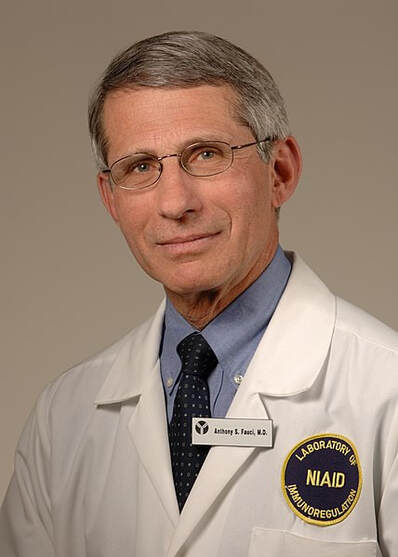 Dr. Anthony Fauci Dr. Anthony Fauci Oh dear, so much COVID-19 misinformation, and conspiracy theories, and so little time and space. Let’s get started. Dr. Anthony Fauci is receiving a lot of criticism from people, ranging from those who deny the severity of COVID-19 and think he misadvised the president, promoting the interests of political elites and the deep state, to those who think he is denying the efficacy of hydroxychloroquine and promoting the economic interests of pharmaceutical companies to the detriment of the interests of patients. These people question his character, and call him a liar, a fraud, a traitor, and a saboteur who should be fired. As it turns out, these insults are nothing compared to the insults levied against him when he was coordinating the nation’s response to the AIDS epidemic in the 1980s. The notorious firebrand AIDS activist Larry Kramer criticized Dr. Fauci for moving too slowly in finding a treatment for AIDS, and said he was evil and represented a callous government. Kramer called Fauci a pill-pushing tool of the medical establishment, an incompetent idiot, a disgrace, and a murderer who should be put in front of a firing squad. Kramer compared him to a Nazi and even insulted Fauci’s wife! So what did Dr. Fauci do? He talked to Kramer and other AIDS activists, he heard their concerns, he realized they had a point, and he pushed for changes in the way clinical trials were conducted speeding up the process, making it more flexible, and giving patients a greater voice. He reached out to those who insulted him and worked with them to change medicine for the better and make history. Eventually, Dr. Fauci and Kramer became good friends. Fauci helped Kramer get medical treatment for his health problems, and Kramer made Fauci a character in one of his award winning plays. So when critics say Dr. Fauci doesn’t care for patients or is beholden to special interests, I am skeptical of these claims. I think that history so far indicates that this is not who Dr. Fauci is. This is not to say that Fauci doesn’t make mistakes, but I certainly believe that he is acting in the best interest of the American people. But can’t people change? Sure, but as far as I’m concerned, the burden of proof is on the critics to produce exceptional evidence that there is a nefarious intent behind his actions.  Hydroxychloroquine Hydroxychloroquine Another conspiracy theory involving Dr. Fauci states that he has known for 15 years that chloroquine (a drug related to hydroxychloroquine) was effective in hindering the spread of a virus, SARS-CoV, which is 79% related to the COVID-19 virus (SARS-CoV-2), in primate cells in culture based on a study published back in 2005. So it is claimed that Fauci is lying when he says that there is no good evidence for the effectiveness of hydroxychloroquine against COVID-19. Dr. Fauci is a competent scientist, and he knows that cell culture is a very preliminary step when employed to look for effective drugs. He knows that the results obtained with this method may not hold in more complete models that better reflect the complexity of the full organism. For example, hydroxychloroquine did not have either a therapeutic or prophylactic effect in hamsters and monkeys infected with the COVID-19 virus. This agrees with the best human studies so far that indicate that hydroxychloroquine is not effective. Another conspiracy theory that is making the rounds concerns retracted articles published in the scientific journals, The Lancet, and the New England Journal of Medicine (NEJM). These two journals published studies where scientists examined a database of patients treated with hydroxychloroquine and concluded not only that hydroxychloroquine was not effective, but that it was also harmful to the patients. The results of these studies led to a temporary halt of several hydroxychloroquine trials taking place worldwide. However, when the studies were examined by scientists, numerous discrepancies in the data and problems in its analysis were detected. Letters signed by more than one hundred scientists were delivered to the Lancet and to the NEJM outlining these problems. The journals expressed concerns about these discrepancies, and the authors of the articles retracted them when they were not able to dispel these concerns with the company that provided them with the hydroxychloroquine dataset. The conspiracy argument alleges that the publication of these articles proves that there is a concerted campaign by the scientific establishment to discredit hydroxychloroquine at the expense of the lives of people who could benefit from it, just to embarrass president Trump for advocating the use of this drug. The conspiracy theory argues that this scandal demonstrates that scientists have lost all credibility. However, what this argument ignores is that it was scientists who detected these problems and alerted the journals, and the journals proceeded to raise concerns with the authors, and the authors acknowledged those concerns and retracted the articles when they could not address said concerns. That this happened is not a scandal. Scientists make mistakes all the time. In fact, that is the strength of science. The only reason that science can be right is because it can be wrong. In this case, error was detected, addressed, and removed. The scandal would have been if the problems with the articles had not been addressed and the articles had not been retracted. The fact that the opposite happened is an indication that science worked the way it should, and vindicates our confidence in the scientific process. Finally, another conspiracy theory involves the claim that countries that have embraced the use of hydroxychloroquine are doing better than countries that haven’t. Therefore, the unwarranted rejection of hydroxychloroquine by the health care systems of some countries has led to many preventable deaths. Those that espouse this conspiracy theory do not make any efforts to address other variables that could explain these differences. For example, there is the number of infected people that spread the disease initially in the country (more disease spreaders equals more infections and more problems with the health care system). There is the timing of the spread of the disease (earlier spread means less time to adapt). There is the constellation of drugs and procedures that are used to treat patients (how do you separate the effect of hydroxychloroquine from that of other drugs and/or procedures). There is the age and health of the population affected (younger healthier people are less susceptible). There is the strength and effectiveness of the mitigation measures employed (older sicker people could have been protected better in one country than in another another). There are differences in reporting what constitutes a COVID-19 death from one country to another. If these and other variables are not considered and controlled for, the claim does not go beyond a mere anecdote. The misinformation and conspiracy theories I’ve mentioned are but a fraction of all the bilge that’s out there, but what they all have in common is that they are part of an effort to disqualify mainstream science and scientists as they deal with COVID-19 and evaluate hydroxychloroquine and other drugs. The image of Dr. Fauci ny NIAID is used here under an Attribution 2.0 Generic (CC BY 2.0) license. The image of hydroxychloroquine by Fvasconcellos is in the public domain. Every activity performed by groups of human beings interacting with each other tends to have some drama, and science is no exception. The quest of scientists to discover, be recognized and respected, and remain relevant has produced amazing stories that form a permanent part of the lore of scientific research. And these stories have it all: triumph and tragedy, the clash of strong willed characters, and the fireworks displays stemming from the mixing of the most honorable and dishonorable aspects of human nature. But these stories seldom make it to the end product of scientific research in which scientists report the results of their work: the scientific article. Scientific articles tend to be highly technical, full of jargon, and are mostly read by specialists. However, many scientific articles have subtle and not so subtle hints of what’s going on behind the science. Today we will take a look at two scientific articles related to two such stories. The first one is the famous article entitled, A structure for deoxyribose nucleic acid, published in the Journal Nature in 1953 by James Watson and Francis Crick. In this article, these two scientists propose a structure for the chemical molecule that contains the blueprint of life: DNA. This article ushered a revolution that changed science and the word forever. The most mentioned passage in this article is the one below: It has not escaped our notice that the specific pairing we have postulated immediately suggests a possible copying mechanism for the genetic material. This whopper of a sentence, which has been described as anything from “coy” to “one of the greatest understatements in the history of science”, makes a reference to the fact that the model of the structure of DNA that Watson and Crick proposed explained a phenomenon which at the time was the holy grail of the biological sciences (how genetic information is copied). However, the passage that reveals some of the human drama behind the science is found in the previous paragraph. The previously published X-ray data on deoxyribose nucleic acid are insufficient for a rigorous test of our structure. So far as we can tell, it is roughly compatible with the experimental data, but it must be regarded as unproved until it has been checked against more exact results. Some of these are given in the following communications. We were not aware of the details of the results presented there when we devised our structure, which rests mainly though not entirely on published experimental data and stereochemical arguments.  Rosalyn Franklin Rosalyn Franklin Watson and Crick never worked with DNA themselves. As they wrote, they relied on work already published by others and on their own theorizing. However, they claim their model agrees with “more exact results” in the following communications. This makes an allusion to two additional articles published simultaneously with theirs by other researchers. Among them was Rosalyn Franklin. Watson and Crick claim they were not aware of the “details” of these results when they put their model together, but this carefully worded statement is misleading. Franklin’s work with DNA was made available to Watson and Crick without her knowledge, and whether detailed or not, it was a crucial part of the puzzle that allowed them to solve the structure of DNA. Watson and Crick would go on to be corecipients of the Nobel Prize for the discovery of the structure of DNA in 1962. Rosalyn Franklin continued her work and went on to make several important discoveries, but died from Cancer in 1958 at the age of 38 never having known that it was her uncredited work that allowed Watson and Crick to figure out the structure of the molecule of life. The second article we will consider today is famous because of its infamy. It is entitled: Warburg Effect Revisited: Merger of Biochemistry and Molecular Biology, and was published in the journal Science in 1981 by Efraim Racker and Mark Spector. 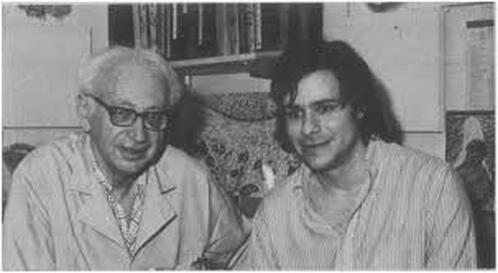 Efrain Racker (left) and Mark Spector (right) Efrain Racker (left) and Mark Spector (right) In the late 1970s, Efraim Racker was one of the surviving elder scientists of biochemistry. He had won numerous awards for his work but not the Nobel Prize. When the 1978 Nobel Prize was awarded to Peter Mitchel for his theory regarding how cells obtain their energy, there was consternation in the scientific world as it had been Racker who had performed the experiments that had conclusively demonstrated Mitchel’s theory to be true. Undeterred by this, at the beginning of the 1980s, Racker took up researching an unexplained phenomenon that he had addressed off and on throughout his career called the Warburg Effect. Normal cells use oxygen as part of the normal mechanism of producing the energy they need. However, when cells become cancerous, they switch their energy producing mechanisms, in large part, to one that does not require oxygen even if oxygen is present. Many scientists think that this switch holds the key to explain what causes cancer and how it can be treated. At the same time a bright Ph.D. student named Mark Spector joined Racker’s lab and began researching the Warburg Effect. Spector proved to be a talented researcher making discoveries in a few months that would take others years. By 1981 he had put together a wonderful story linking cancer-causing genes to signaling pathways that led to changes in the bioenergetics of the cells which explained the Warburg Effect. This result was really big, and probably Nobel Prize material. The Warburg effect’s relation to cancer had not been explained for decades. Racker was elated. The passage in the article that best describes the sense of fulfilment, optimism, and aspirations that Racker had is the first sentence which is not even a scientific statement but a quote from the English writer Gilbert K. Chesterton. There are no rules of architecture for a castle in the clouds. And herein lies the brutal irony of this story. Spector tuned out to be a con-man. He had falsified the data! Racker retracted the article and dismissed Spector from his lab. Racker would still perform important research for the next decade, but the Nobel Prize would elude him. He died from a stroke in 1991. The Warburg Effect remains unexplained, and is still an active area of investigation in cancer. These are but two of the thousands of stories lurking behind the technical jargon, the graphs, and the tables in the pages of the scientific literature. Photos of Rosalind Franklin by Silver Screen and of James Watson by the National Cancer Institute are in the public domain. Photo of Francis Crick by Marc Lieberman used here under an Attribution 2.5 Generic (CC BY 2.5) license. I do not own the copyright to the articles mentioned here from which the text is quoted or the image of Efrain Racker and Mark Spector from the journal Science (Vol. 214, No. 4518 (Oct. 16, 1981), pp. 316-318), Copyright Cornell University. These are used here under the doctrine of Fair Use. |
Details
Categories
All
Archives
June 2024
|
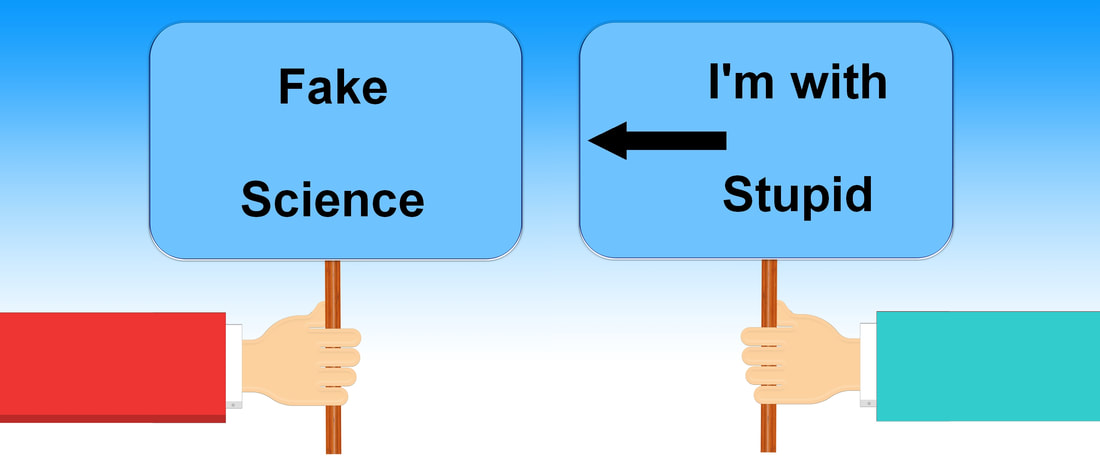
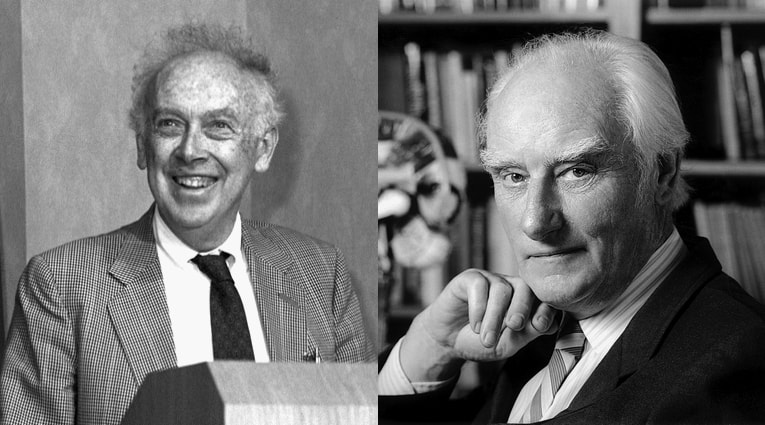
 RSS Feed
RSS Feed